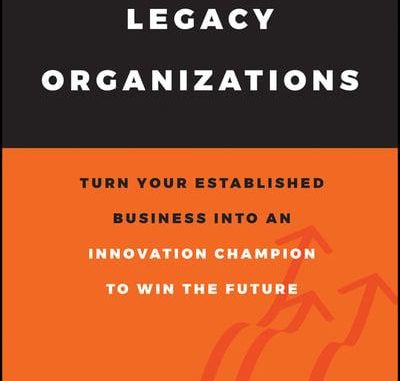
Kris Oestergaard realizes we live in a fast moving society and never wastes reader’s time. His book Transforming Legacy Organizations plunges headlong into an intelligent discussion about how long standing and successful business organizations can prioritize innovation as a critical aspect of their ongoing future plans and maintain relevancy in an ever-changing commercial marketplace. There is no wasted motion in his presentation and Oestergaard latches onto language that clearly lays out the essential ingredients for making this happen and potential red flags and setbacks that might be met along the way. He, likewise, backs up his ideas with a wealth of personal experience he shares without hesitation and research backing his claims.
The book divides into three sections dealing with pivotal benchmarks an organization must address in order to make innovation a keystone element of their business plan. The first part locks in on the idea that a company needs to embrace an overriding purpose behind their pursuit of innovation. Oestergaard cites Tesla as his favorite example of establishing an overall purpose – while the company involves itself in an array of seemingly disparate projects, they are all united by the common and ambitious goal of advancing human potential in the 21st century and beyond. He believes it is more important than ever that a company define themselves and their purpose in the world – it was once more than adequate for a company like Tesla to say they are in the business of designing and manufacturing cars, but they are much more than that in 2019 and encompassing the full gamut of their pursuits into an unified mission statement of sorts is essential to laying the groundwork for innovation.
GOODREADS: www.goodreads.com/book/show/44327484-transforming-legacy-organizations
The first section of the book hints at the gist of the section part. The discussion of personal, societal, and organizational bias sets up the second section well with its examination of how similar immune systems may curtail or pose threats to an organization’s capacity for innovation. Oestergaard puts forth reading, experience, and research to back these claims while also providing his readers with a clear antidote to such problems as they arise. His reading of human nature is fundamental to understanding the issues this section presents – namely how many of us resist change if it threatens time-tested stability.
KRIS OESTERGAARD ON TWITTER: twitter.com/krisoestergaard
In the book’s final half, Oestergaard presents readers with a three pronged approach to tackling innovation – optimization, augmentation, and mutation. It behooves any company, legacy or start up, to fine tune their innovative efforts for the best possible results. Staying abreast of the consumer’s needs while looking to constantly perfect your product(s) is crucial for sustaining ongoing relevancy and market share. Augmenting innovation can mean different things, but Oestergaard convincingly argues that utilizing the latest and emerging technological advancements to enhance a company’s innovative powers is indispensible. The third and final element, mutation, echoes his past warning that maintaining the status quo will not do – it is certain organizational structures will continue to evolve as society marches on and remaining open to new ways of structuring one’s business model is an essential aspect of innovation. Kris Oestergaard’s Transforming Legacy Organizations is an essential guidebook of sorts for anyone or group interested in leading the charge into a brave new world.
Clay Burton
